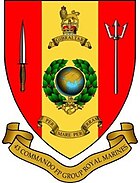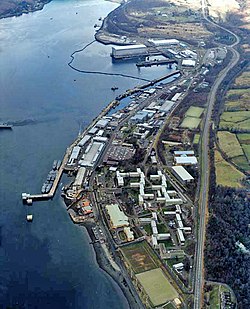The43 Commando Fleet Protection Group Royal Marines(43 Cdo FP Gp RM),[5]formerlyComacchio Company Royal Marines(1980–1983),Comacchio Group Royal Marines(1983–2001) andFleet Protection Group Royal Marines(2001–2012), is a 550-man unit of theRoyal Marinesresponsible for guarding theUnited Kingdom'snuclear weapons.The unit, based at HM Naval Base Clyde, is part ofUK Commando Force.
| 43 Commando Fleet Protection Group Royal Marines | |
|---|---|
 Unit badge | |
| Active | 1943–1946 1961–1968 1980 – present |
| Country | |
| Branch | |
| Type | Commando |
| Role | Force protection Maritime Interdiction Operations Nuclear Security |
| Size | 550 personnel[1] |
| Part of | UK Commando Force[2] |
| Base | HMNB Clyde |
| Nickname(s) | FPG |
| Motto(s) | Per Mare Per Terram(By Sea By Land) (Latin) |
| Colours (Lanyard) | Red and Old Gold |
| March | Quick –A Life on the Ocean Wave Slow –Preobrajensky |
| Anniversaries | Lake Comacchio, 3 April 1945 |
| Website | 43 Commando Fleet Protection Group Royal Marines |
| Commanders | |
| Captain General | The King[3] |
| Commandant General | GeneralGwyn Jenkins[4] |
| Superior Commander | Commander Operations, Fleet Headquarters |
| Current Commander | Colonel Tony de Reya RM MBE |

It inherited the traditions and battle honours of the Second World WarNo. 43 (Royal Marine) Commandos.
History
editSecond World War
editEarly Commando units were all from theBritish Army.In February 1942, the Royal Marines were asked to organize Commando units of their own, and 6,000 men volunteered.[6]
In July 1943, 43 Commando was formed, after the conversion of thebattalionsof theRoyal Marine Divisioninto commando units.[7]The initial intake of personnel was drawn from the 2nd Battalion, Royal Marines.[8]Following commando training at Achnacarry in Scotland, the unit consisted of about 450 men organized into a headquarters, fiveinfantrytroopsconsisting of threeofficersand 63other ranks,along with a heavy weapons troop—armed withVickers machine guns,3-inch mortarsand6-pounder anti-tank guns—and a signals platoon.[9][10]
Along withNo. 2,No. 9andNo. 40 (Royal Marine) Commandos,43 Commando formed the2nd Special Service Brigade.[11]In 1943–45, No. 43 (Royal Marine) Commando served inItaly,YugoslaviaandGreece.[12]
Victoria Cross
editCorporalThomas Peck Hunterwas posthumously awarded theVictoria Crossfor his actions duringOperation RoastatLake Comacchio,Italyduring theSecond World War.Hunter cleared a farmhouse containing threeMG42 machine-gunson his own, firing aBren Gunfrom his hip. Hunter then proceeded to draw enemy fire until most of his troop had taken cover.[13]TheCommanding Officer,Lieutenant ColonelIan RichesRM was awarded theDSOin this action. He went on to beCommandant General Royal Marinesbetween 1959 and 1962.[14]
Re-formed
editIn 1961, 43 Commando RM was reformed atStonehouse Barracks"as a further contribution to the forces available for seaborne operations".[15][16]The unit was disbanded again in 1968.[15]
Comacchio Company
editOn 1 May 1980, the Comacchio Company Royal Marines was formed - taking its name from the battle honour "Comacchio,Italy 1945 ", where Hunter posthumously received the Victoria Cross for his actions.[17]On its formation, Comacchio Company took on the colours and traditions of the then-defunct 43 Commando.[18]The company's purpose was to guard the UK's Naval nuclear weapons and be a maritimecounter-terrorismunit for offshore installations, including oil rigs and ships.[18]The company initially numbered around 424 personnel.[18]
In November 1983, the Comacchio Company RM became Comacchio Group RM.[18]In 1987, Comacchio Group ceased performing the maritime counter-terrorism role after a study transferred the task to the newly formed M-squadron of the Royal MarinesSpecial Boat Service.[18]
Fleet Protection Group Royal Marines
editIn March 2001, the Comacchio Group RM was renamed Fleet Protection Group Royal Marines, and restructured into its current organisation.[18]The Group moved fromRM CondorinArbroathAngus,where it was co-located with45 Commando,toHM Naval Base Clyde,which is situated nearHelensburgh,Argyll and Bute,both inScotland.[18]
In 2012, FPGRM formally adopted the name 43 Commando Fleet Protection Group Royal Marines.[19]
In 2016, elements of the unit began using theColt Canada C8carbine instead of the standardL85A2.[20]
Commandos from 43 Commando regularly train with other forces both inside the UK and other nations including theUS Marines.[21][22]
Tasks and organisation
editThe primary mission is to prevent unauthorised access to the UK's strategic nuclear deterrent through the provision of specialist military capability. Additionally,maritime boardingand sniper teams and the very high readiness Fleet Contingent Troop are deployed world-wide to conduct specialist maritime security tasks in support of the Royal Navy.[23]
43 Commando Fleet Protection Group Royal Marines is a Royal Marine Unit based at HM Naval Base Clyde in Scotland and is part ofUK Commando Force,the UK's high readiness expeditionary amphibious force.[23]
As of 2016, 43 Commando Fleet Protection Group Royal Marines has over 550 personnel and is organised into several sub-units:[23]
- HQ headquarters squadron
- O Rifle Squadron[23]
- P Rifle Squadron (reformed in 2018)[23][24]
- R Rifle Squadron[23]
-
Members of 43 Commando Fleet Protection Group Royal Marines train usingL119A1 carbinesfitted with a CQB upper receiver.
-
Royal Marines from 43 Commando Fleet Protection Group conducting an ‘Underway Boarding Exercise’ in conjunction with a local ferry, 2015.
Royal Navy Reserve Augmentation
editNaval ratings of theRoyal Naval Reservehave been attached to 43 Commando Fleet Protection Group Royal Marines, to support the force protection tasks outside of the United Kingdom. This organisation was known as P Squadron. It was disbanded, with the force protection duties being transferred to the standing tasks commando unit, a duty which rotates annually between Commando units.[25]
See also
editReferences
edit- ^"43 Commando".Retrieved24 February2021.
- ^"43 Commando".Royal Navy.Retrieved4 April2012.
- ^"His Majesty The King is announced as Captain General Royal Marines on the 358th Anniversary of the Corps".The Royal Household.28 October 2022.Retrieved28 October2022.
- ^"Royal Marines appoint new Commandant General".forces.net. 25 November 2022.Retrieved27 November2022.
- ^"43 Commando resurrected as historic Royal Marines unit returns".Archived fromthe originalon 4 April 2012.Retrieved3 April2012.
- ^Haskew, pp. 48–49
- ^Neillands 2004, pp. 81–82.
- ^Neillands 2004, p. 81.
- ^Neillands 2004, p. 79.
- ^Saunders 1959, p. 180.
- ^Chappell 1996, p. 28.
- ^Neillands 2004, p. 78.
- ^"Ninth Supplement".The London Gazette(37127). London: 3087. 12 June 1945.
- ^Obituary: General Sir Ian RichesThe Independent, 6 January 1997
- ^ab"43 Commando".British Army units 1945 on.Retrieved15 July2017.
- ^"The Naval Review, Vol XLIX, No 3 dated July 1961, p292"(PDF).1961. Archived fromthe original(PDF)on 2 March 2012.Retrieved12 April2010.
- ^"No. 37127".The London Gazette(Supplement). 12 June 1945. pp. 3087–380.
- ^abcdefg"Fleet Protection Group"(PDF).RM Historical.Retrieved15 July2017.
- ^43 Commando resurrected as historic Royal Marines unit returns– Royal Navy, 04/04/12
- ^"UK Royal Marine unit ditches the SA80 for Colt C8".Archived fromthe originalon 17 March 2016.Retrieved4 April2016.
- ^"43 Commando FPG on TARTAN EAGLE 23".Joint Forces News.10 September 2023.Retrieved6 April2024.
- ^Candlin, Alex (6 September 2023)."Royal Marines sharpen skills to protect the UK's nuclear deterrent".Forces Network.Retrieved6 April2024.
- ^abcdef"Fleet Protection Group".Elite Forces.Retrieved15 July2017.
- ^"Royal Marines storm the Rock to protect Britain's ultimate weapon".Royal Navy.Retrieved11 September2018.
- ^HMS Eagletaccessed 14 December 2015